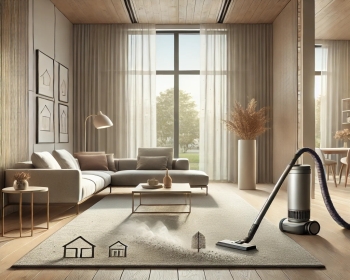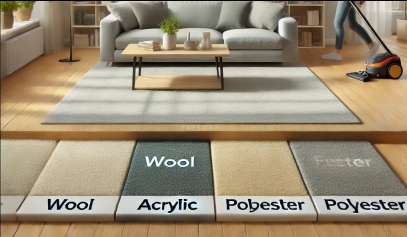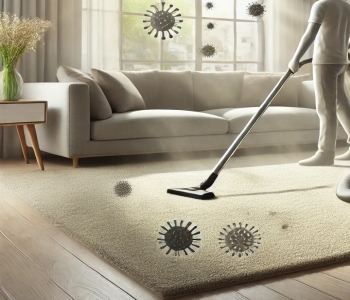Carpet and Asthma: Myths, Facts, and the Best Rugs for Allergy Sufferers

Carpets have long been a controversial topic for asthma and allergy sufferers. Some believe that carpets trap allergens like dust mites, pet dander, and pollen, making symptoms worse. Others argue that modern carpets, when properly maintained, can actually improve indoor air quality by capturing airborne particles. With so much conflicting information, it’s crucial to separate myths from reality and understand how different types of carpets affect those with respiratory conditions.
In this article, we’ll explore the real relationship between carpets and asthma, debunk common misconceptions, and highlight the best rug options for allergy sufferers. We’ll also provide expert-backed cleaning and maintenance tips to help minimize allergens, ensuring a healthier living environment. By the end, you’ll have a clear understanding of whether carpets are a friend or foe for asthma sufferers and how to make informed flooring choices.
The Link Between Carpet and Asthma: Myth vs. Reality
The relationship between carpets and asthma has been the subject of extensive scientific research, leading to the debunking of several prevalent myths. A comprehensive review by toxicologist Dr. Mitchell W. Sauerhoff concluded that carpets do not cause or exacerbate asthma or allergies. In fact, multiple studies have reported fewer allergy and asthma symptoms associated with carpeted environments.
One common misconception is that carpets release high levels of volatile organic compounds (VOCs), which can trigger asthma symptoms. However, research indicates that VOC emissions from new carpets are minimal and dissipate quickly, posing no significant health risks. A study by ENVIRON International Corporation found no human health concerns with components of, or emissions from, carpet.
Another myth suggests that carpets contribute to increased allergen exposure. Contrary to this belief, carpets can act as filters, trapping allergens and preventing them from becoming airborne. Regular cleaning and maintenance can effectively remove these trapped particles, thereby improving indoor air quality. The Carpet and Rug Institute notes that effectively cleaned carpets have the capacity to trap allergen and microbial particles, making these particles less available to become airborne and thus maintaining indoor air quality.

In summary, well-maintained carpets do not increase the risk of asthma or allergies and can contribute to a healthier indoor environment by trapping allergens and reducing airborne particles.
How Carpets Affect Indoor Air Quality
Carpets play a complex role in indoor air quality (IAQ), acting both as potential sources of pollutants and as reservoirs for particulates. New carpets can emit volatile organic compounds (VOCs), such as 4-phenylcyclohexene, which contribute to the "new carpet" smell. These emissions are typically highest immediately after installation and decrease over time. Proper ventilation during and after installation can help mitigate VOC concentrations.
Beyond chemical emissions, carpets can accumulate dust, allergens, and other particles. While they can trap these particulates, preventing them from becoming airborne, disturbances like walking or vacuuming can resuspend them into the air, potentially affecting IAQ. Regular cleaning and maintenance are essential to manage this resuspension and maintain a healthy indoor environment.
The impact of carpets on IAQ is influenced by factors such as carpet material, maintenance practices, and environmental conditions. Selecting carpets with low VOC emissions, ensuring proper installation, and adhering to a consistent cleaning regimen can help minimize potential negative effects on indoor air quality.
Best Carpet Materials for Asthma and Allergy Sufferers
Choosing the right carpet material is crucial for asthma and allergy sufferers, as certain fibers can help minimize allergen accumulation and improve indoor air quality. Here are some of the best carpet materials to consider:
Wool Carpets
Wool is a natural fiber renowned for its hypoallergenic properties. Its unique coil-like structure helps trap dust, pollen, and other airborne particles, preventing them from circulating in the air. Additionally, wool's low moisture content makes it inhospitable for dust mites, a common allergen trigger. Studies have shown that wool carpets can even absorb indoor air pollutants, acting as a natural air purifier.
Acrylic Carpets
Acrylic is a durable synthetic fiber that resists dirt, moisture, and mildew, making it a suitable choice for allergy sufferers. Short fibre acrylic carpets are particularly effective, as their shorter fibers make cleaning easier and reduce the likelihood of allergen accumulation. Regular maintenance of acrylic carpets can help maintain a healthier indoor environment.
Polyester Carpets
Polyester carpets offer a soft texture and are inherently resistant to mold and mildew. They repel moisture, which helps prevent the growth of allergens. However, it's essential to choose high-quality polyester carpets, as lower-quality options may not provide the same level of allergen resistance.
When selecting a carpet, it's also important to consider factors such as fibre height and density. Opting for short fibre carpets can reduce the spaces where allergens can hide, making cleaning more effective. Additionally, ensure that the carpet is certified as low in volatile organic compounds (VOCs) to minimize potential respiratory irritants.

By carefully choosing the right carpet material and maintaining it properly, asthma and allergy sufferers can enjoy the comfort of carpeting without compromising their health.
Cleaning and Maintenance Tips to Reduce Allergens in Carpets
Maintaining clean carpets is essential for asthma and allergy sufferers, as carpets can harbor allergens like dust mites, pet dander, and pollen. Implementing effective cleaning and maintenance practices can significantly reduce these allergens and improve indoor air quality. Here are some expert-recommended strategies:
- Regular Vacuuming
Frequent vacuuming is crucial to remove surface allergens before they settle deep into the carpet fibers. Use a vacuum equipped with a High-Efficiency Particulate Air (HEPA) filter, which effectively traps small particles and prevents them from being released back into the air. Aim to vacuum high-traffic areas at least twice a week and other areas weekly.
- Professional Deep Cleaning
Even with regular vacuuming, some allergens can remain embedded in the carpet. Scheduling professional deep cleaning every 12 to 18 months is recommended to remove these deep-seated contaminants.
- Immediate Spill Management
Promptly addressing spills and stains prevents moisture from seeping into the carpet, which can lead to mold growth—a known asthma trigger. Blot spills with a clean cloth and use appropriate cleaning solutions to treat stains. Ensure the area is thoroughly dried to prevent mold and mildew development.
- Control Indoor Humidity
Maintaining indoor humidity levels between 30% and 50% helps inhibit the growth of dust mites and mold. Use dehumidifiers and ensure proper ventilation, especially in areas prone to moisture, like basements and bathrooms. Regularly check for and address any sources of leaks or dampness.
- Implement a No-Shoes Policy
Encouraging a no-shoes policy indoors can significantly reduce the introduction of outdoor allergens and dirt into your living spaces. Place doormats at entryways and consider providing indoor slippers for household members and guests.

By following these cleaning and maintenance practices, you can effectively reduce allergen levels in your carpets, leading to a healthier indoor environment for asthma and allergy sufferers.
Alternative Flooring Options for more Severe Asthma Sufferers
For individuals with more severe asthma, selecting flooring that minimizes allergen accumulation and promotes better indoor air quality is crucial. While certain carpets are designed to be hypoallergenic, hard flooring options are generally more effective in reducing exposure to asthma triggers.
When choosing alternative flooring, it's important to consider factors such as durability, maintenance, and the presence of volatile organic compounds (VOCs) in adhesives and finishes. Opting for materials with low VOC emissions and maintaining a regular cleaning routine can significantly improve indoor air quality for asthma sufferers.
Conclusion: Can You Have Carpets with Asthma?
The relationship between carpets and asthma is multifaceted, with both potential benefits and drawbacks. While carpets can trap allergens, preventing them from becoming airborne, they can also harbor dust mites, pet dander, and other pollutants if not properly maintained. Regular cleaning, including vacuuming with HEPA filters and periodic professional deep cleaning, is essential to minimize allergen accumulation. For individuals with severe asthma or allergies, alternative flooring options like hardwood, tile, or linoleum may be more suitable, as they are easier to clean and less likely to retain allergens. Ultimately, the decision to have carpets should be based on individual sensitivities, lifestyle, and commitment to maintenance. Consulting with healthcare professionals can provide personalized guidance to ensure a healthy living environment.
FAQ
- Do carpets worsen asthma symptoms?
Carpets can trap allergens such as dust mites, pet dander, and pollen, which may trigger asthma symptoms in sensitive individuals. However, regular cleaning and maintenance can reduce these allergens, potentially minimizing their impact.
- Are certain types of carpets better for asthma sufferers?
Short fibre carpets are generally recommended for asthma sufferers because they trap fewer allergens and are easier to clean compared to high fibre carpets. Additionally, choosing carpets made from hypoallergenic materials can further reduce the risk of triggering asthma symptoms.
- How often should carpets be cleaned to minimize asthma triggers?
It's advisable to vacuum carpets at least once or twice a week using a vacuum equipped with a HEPA filter to effectively remove allergens. Additionally, professional deep cleaning should be performed annually to eliminate deeply embedded particles.
- Can removing carpets improve asthma symptoms?
Replacing carpets with hard flooring can reduce allergen accumulation, as hard surfaces are easier to clean and do not harbor allergens like carpets can. This may lead to an improvement in asthma symptoms for some individuals.
- Are there any benefits to keeping carpets for asthma sufferers?
Some studies suggest that carpets can act as filters, trapping allergens and preventing them from becoming airborne. When properly maintained, carpets may contribute to better indoor air quality by keeping allergens out of the breathing zone.
